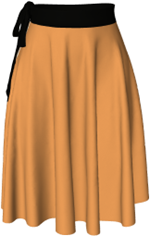Exploring the attractiveness of combinations of natural colors and contemporary shapes in fashion design
DOI:
https://doi.org/10.25367/cdatp.2023.4.p273-283Keywords:
color preference, form analysis, emotion, online survey, principal component analysis, fashion designAbstract
In this research, the attractiveness of combinations of natural colors and contemporary shapes in fashion design is explored. This was done by means of a questionnaire survey. Four shapes of clothing and ten colors obtained from plant and insect pigments are proposed. The research was conducted in two phases – qualitative and quantitative analysis. The quantitative study confirmed the results of the qualitative study and using an appropriate data reduction method, the study results were analyzed graphically. The results showed that users rated designs with high-contrast color and shape combinations as more attractive than those with low-contrast combinations. The study also showed that in addition to the shape of the garment, the choice of natural color sources can also influence consumer preferences. This study aims to overcome the shortcomings of previous studies that only examined color without investigating its relationship to garment shape. The knowledge gained from this study can help fashion designers create garments that are both aesthetically pleasing and environmentally friendly. However, further research is needed to determine the relationship between natural colors, contemporary shapes and consumer behavior in selecting them.
References
Dineva, P. Design of peplums with different forms in ladies' dresses. In Proceedings of the International Conference in Technics, Technologies and Education ICTTE, 2014, pp. 291-301. (in Bulgarian)
Entwistle, J. The fashioned body: Fashion, dress and modern social theory. John Wiley & Sons, ISBN 978-074-564-938-2, 2015. DOI: 10.1177/0959353516682662.
Stoykova, V. Interactive environments for training in the higher education. In Proceedings of International Conference on e-Learning, e-Learning’15, 2015, Berlin, Germany, pp. 268-273.
Kosinkova-Stoeva, A. Research on color and shape combinations of Minoan style dresses. ARTTE 2021, 9 (1), 9-18.
Spahiu, T.; Manavis, A.; Kazlacheva, Z.; Almeida, H.; Kyratsis, P. Industry 4.0 for fashion products – Case studies using 3D technology. IOP Conf. Ser.: Mater. Sci. Eng. 2021, 1031 (1), 012039. DOI: 10.1088/1757-899X/1031/1/012039.
İşmal, Ö. Patterns from Nature: Contact Printing. J. Text. Assoc. 2016, 77 (1), 81-91.
Che, J.; Yang, X. A recent (2009-2021) perspective on sustainable color and textile coloration using natural plant resources. Heliyon 2022, 8 (10), e10979. DOI: 10.1016/j.heliyon.2022.e10979.
Sanchiher, L.; Babel, S. Eco friendly natural dyes. Asian J. Home Sci. 2017, 12 (2), 631-635. DOI: 10.15740/HAS/AJHS/12.2/631-635.
Lara, L.; Cabral, I.; Cunha, J. Ecological Approaches to Textile Dyeing: A Review. Sustainability 2022, 14, 8353. DOI: 10.3390/su14148353.
Kodžoman, D.; Hladnik, A.; Čuden, A.; Čok, V. Exploring color attractiveness and its relevance to fashion. Color Res. Appl. 2022, 47 (1), 182-193. DOI: 10.1002/col.22705.
Kazlacheva, Z. Optimum use of drawing tools in cad systems in automated apparel design. Trakia Journal of Sciences 2005, 3 (7), 20-23.
NATCOL, Introduction to Natural Food Colors. https://natcol.org (accessed 2023-04-07).
The types of natural colors. https://learn.ddwcolor.com (accessed 2023-04-07).
Zhang, Y.; Li X. Models of clothing based on combinations of colors and shapes inspired by natural sources. J. Text. Appar. Technol. Manag. 2020, 11 (4), 1-10.
Parthasarathi, V.; Kumar R. Natural colorants and dyeing techniques in textile industry: an overview. J. Text. Inst. 2016, 107 (4), 493-507.
Ou, L.; Luo, M. A review of current color preferences and their applications in fashion design. Int. J. Fash. Des. Technol. Educ. 2014, 7 (3), 163-174.
Arora, J.; Agarwal, P.; Gupta, G. Rainbow of Natural Dyes on Textiles Using Plants Extracts: Sustainable and Eco-Friendly Processes. Green Sustain. Chem. 2017, 7, 35-47. DOI: 10.4236/gsc.2017.71003.
Suhr, D. Principal component analysis vs. Exploratory factor analysis. SUGI 30, Statistics and Data Analysis, 2005, pp. 203-230.
Mladenov, M. Model-based approach for assessment of freshness and safety of meat and dairy products using a simple method for hyperspectral analysis. J. Food Nutr. Res. 2020, 59 (2), 108-119.
Vasilev, M.; Shivacheva, G.; Krastev, K. Predicting the day of storage of dairy products by data combination. IOP Conf. Ser.: Mater. Sci. Eng. 2021, 1031, 012056. DOI: 10.1088/1757-899X/1031/1/012056.

Downloads
Published
How to Cite
Issue
Section
License
Copyright (c) 2023 Krasimira Genova, Julieta Ilieva, Irina Ruseva, Liliana Doble, Gabriella Böhm, Zlatin Zlatev

This work is licensed under a Creative Commons Attribution-NonCommercial-NoDerivatives 4.0 International License.





